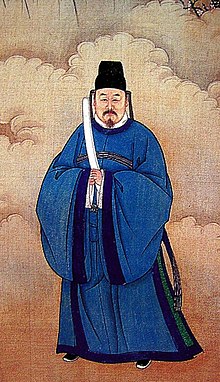Jinshi
This article has multiple issues.Please helpimprove itor discuss these issues on thetalk page.(Learn how and when to remove these template messages)
|

| Jinshi | |||||||||||||||||||
|---|---|---|---|---|---|---|---|---|---|---|---|---|---|---|---|---|---|---|---|
| Chinese name | |||||||||||||||||||
| Traditional Chinese | Tiến sĩ | ||||||||||||||||||
| Simplified Chinese | Tiến sĩ | ||||||||||||||||||
| Literal meaning | "entered scholar" | ||||||||||||||||||
| |||||||||||||||||||
| Vietnamese name | |||||||||||||||||||
| Vietnamese alphabet | Tiến sĩ | ||||||||||||||||||
| Chữ Hán | Tiến sĩ | ||||||||||||||||||
Jinshi(Chinese:Tiến sĩ;pinyin:jìnshì) was the highest and final degree in theimperial examinationinImperial China.[1][2]The examination was usually taken in the imperial capital in the palace, and was also called theMetropolitan Exam.Recipients are sometimes referred to in English-language sources asImperial Scholars.[3]
Thejinshidegree was first created after the institutionalization of the civil service exam. Initially it had been "for six categories" but was later consolidated into a single degree. This system first appeared during theHan dynasty(206 BC – AD 220).[2]Throughout theTang dynasty,every year around one to two percent of test takers would obtain ajinshititle out of a total of one to two thousand test takers.[4]
The numbers ofJinshidegrees given out were increased in theSong dynasty,and the examinations were given every three years. Most senior officials of the Song dynasty werejinshiholders.[5]
TheMing dynastyresumed the civil-service exam after its occurrence became more irregular in theYuan dynasty.After the reign of theEmperor Yingzong of Ming,it became the rule that only jinshi holders could enter theHanlin Academy.On average around 89jinshiper year were conferred.[6]
During theQing dynastyaround 102jinshidegrees were given a year.
The highest scoringjinshiin the country was known as thezhuangyuan,a term that survives today as a high scoringgaokaotest taker or just someone who is very good at a skill.
Subtypes of jinshi recipients[edit]
- Jinshi Jidi(Tiến sĩ cập đệ,lit. "distinguishedjinshi"), graduates ranked first class in the court exam, usually only the top three individuals were qualified for this title.
- Zhuangyuan(Trạng nguyên,lit. "top thesis author" ), thejinshiwho ranked first overall nationwide.
- Bangyan(Bảng nhãn,lit. "eyes positioned alongside" ), thejinshiwho ranked second overall just belowzhuangyuan.
- Tanhua(Tham hoa,lit. "flower snatcher" ), thejinshiranked third overall.
- Jinshi Chushen(Tiến sĩ xuất thân,lit. "jinshibackground "), the graduates who ranked second class in court exam, ranking immediately after thetanhua.
- Tong Jinshi Chushen(Đồng tiến sĩ xuất thân,lit. "along withjinshibackground "), graduates ranked third class in the court exam.

See also[edit]
Notes[edit]
References[edit]
- ^The Chinese Imperial Examination System: An Annotated Bibliography.
- ^abHagras, Hamada (2019-12-20)."The Ming Court as Patron of the Chinese Islamic Architecture: The Case Study of the Daxuexi Mosque in Xi'an".SHEDET(6): 134–158.doi:10.36816/shedet.006.08.
- ^"Scholar-Officials of China | Essay | The Metropolitan Museum of Art | Heilbrunn Timeline of Art History".The Met’s Heilbrunn Timeline of Art History.Retrieved2023-10-06.
- ^Fu, Zhengyuan.Autocratic Tradition and Chinese Politics.p. 98.
- ^History of Song
- ^Ho 1962
